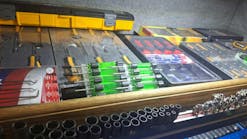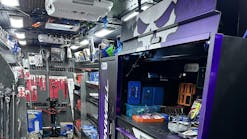Content brought to you by Professional Distributor. To subscribe, click here.
It wasn’t all that long ago when thermal imaging cameras were only thought to be used by home inspectors, military personnel, or first responders. In recent years, not only did the technology advance, but the applications widened as well. Thermal imaging cameras are now a highly recommended diagnostic tool for automotive technicians.
“In the last couple of years, thermal imaging cameras have become more popular than in years past,” confirms Cornwell Quality Tools distributor Jay Hashagen.
Hashagen has been in the tool selling business for over 25 years and is currently driving over 350 miles and spending an average of 58 hours a week on the truck. His route, located between Seattle, Washington and Portland, Oregon, consists of shops ranging from small engines and RV dealerships to small automotive repair shops and heavy duty equipment shops.
Before putting in the extra hours on the road, Hashagen was a volunteer firefighter. Having prior experience with thermal imaging cameras, he has seen firsthand how technology – and price – has changed over the years.
“Nowadays, you get a better unit for less,” he notes. “A unit now that costs $450 would have cost $800 to $1,000 five years ago and it probably has better resolution.”
Since a thermal imaging camera is not a frequent purchase item like a hand or specialty tool, sales can be a bit sporadic.
“I may go two months without selling one but then I’ll sell two in three weeks,” he says. “It all depends on what guys are working on.”
Regardless, Hashagen makes sure to keep thermal imaging cameras stocked on this truck.
“It’s a specific diagnostic tool,” he says. “Not one that you plug into the car and use every time but it’s a time saver, that’s what it is.”
Why thermal imaging?
By detecting infrared energy (or heat), thermal imaging cameras can quickly and accurately identify temperature differences and abnormalities using a non-invasive and non-destructive approach.
As vehicles become more complicated, more technicians are starting to lean towards using thermal imaging cameras, says Doug Constable, project manager, hardware product development department, Innova Electronics.
“The biggest benefit is that [thermal imaging cameras] can actually pinpoint an area that is either running hot or cold and it does it pretty quick,” he notes. “If a technician were to think the wiring or the cooling system was getting too hot or cold, it’ll let them know right away.”
“Noise is a subjective matter, but temperature is not,” adds Haakan Light, training and development manager at TOPDON USA. “[Thermal imaging cameras] take away a level of subjectivity to some of the analyses the shops will have.”
But that’s not to confuse a thermal imaging camera with a digital temperature or thermometer gun.
“Thermal imagers are superior to a temperature gun because you see the entirety of the component and it’s temperature gradient represented by color,” Lights says. “If you aim that one tiny laser pointer on a temperature gun at the wrong spot on a component, you could get a reading that’s misleading. A thermal imager takes away that error from the user by showing a temperature gradient.”
Gaining momentum in the auto industry
As mobile tool distributor Hashagen previously noted, technicians are turning to thermal imaging cameras more and more, and for good reason.
“We’ve definitely seen over the last two years an uptick in sales,” Innova Electronics’ Constable says. “I think one of the reasons why is that it used to be over $1,000. [Also] people are getting more familiar with them. There’s definitely more education out there now for the technicians to understand why it’s important to have one.”
Oasis Scientific’s President Michael Hong agrees that affordability is one main reason. Another reason he adds is efficiency.
“Saving time, labor, and being able to print out diagnostics with technical and visible results for your team or to your customers are a great way to explain and provide a visual representation of the problem,” he says.
By becoming more affordable and understanding the tool better, technicians are finding creative ways to use thermal imaging cameras aside from the more commonly known applications, such as looking for electrical resistance, battery draw testing, and inspecting brake issues.
“A/C diagnostics is one that a lot of folks don’t think of, like finding a restriction in an A/C condenser,” TOPDON’s Light says. “A/C is one that gets missed a lot by shops with a thermal imager. You can find smoking gun problems very quickly with a thermal imager on an A/C where you would not in many other situations.”
“We know a lot of small shops, especially here in California, are using thermal imaging cameras on catalytic converters to see what the actual temperature running is,” Constable adds.
Hashagen also notes that many of his customers use thermal imaging cameras to check heated mirrors, heated and cooling seats, leaks, and to diagnose a vehicle’s manifold.
Deciding factors
Although a thermal imaging camera is pretty straightforward to use — simply aim at the suspected component on a vehicle — there are a few factors and specifications technicians should know and consider before purchasing.
First and foremost, which style is best for them.
There are three types to choose from: a handheld with a trigger, one that is palm-sized, and one that connects to a smartphone.
The handheld with a trigger is easy to hold and is commonly known as the more traditional style. The palm-sized one is more compact, making it easier to transport and store. Then lastly, there’s one that turns any smartphone or even a laptop or iPad into a thermal imaging camera by plugging into the device’s port and downloading an app.
The next factor to consider is thermal resolution.
“A higher resolution camera will allow clearer images of the disparity in temperatures and at greater distances,” says Courtland West, senior sales and marketing manager at Oasis Scientific.
A 160 by 120 camera is good for detecting general problems but for crisper and sharper images, one would want to go with a camera that has a 320 by 240 resolution or a 250 by 190 resolution, West says.
Temperature range is another big one to consider. Most would think the wider the range, the better. However, it all depends on the types of repairs the technician works on.
“Most shops don’t need a super high temperature range unless they’re going to be looking at exhaust or other things with extreme temperature,” Light says.
If your customers work on catalytic converters, they will also need one with a higher temperature range.
“Catalytic converters get up to 1,000 to 1,500 degrees F,” Constable says. “If [a thermal imaging camera] only goes up to 500 degrees F, you don’t want to burn that thing.”
If unsure whether future repairs will require a higher temperature range, Light advises, “It’s better to have something and not need it, then to not have it.”
Other notable specs your customers may want to consider include frame rate, the color modes it offers, storage size/capability, ability to capture video, user interface customization, whether it can operate via AC power while using, how durable it is, and its screen size.
Oasis Scientific’s most popular model, the Vividia HT-19 Infrared Thermal Imaging Camera, features a thermal resolution of 320 by 240, a 3.2” display, offers five different color palettes, and includes a 3GB built-in memory card for convenient storage. It’s also rechargeable and weighs less than a pound.
“A variety of color modes provide different perspectives that correspond with the viewers eyesight,” West notes. Although the different color modes, or palettes, display the same data just in a different way, they prove a level of consistency on a variety of spectrums.
The 3360 Multi-Purpose Infrared Inspection Camera, Innova Electronics’ latest thermal imaging camera, has a 2.4” LCD display, built-in LED flashlight, is IP54 rated, and has a temperature range of -4 to 1,832 degrees F.
In addition to its 7.8MB internal storage, users can also add an SD card for an unlimited amount of storage, notes Constable.
The TOPDON TC003 Infrared Thermal Imager is based on a mini-Android tablet. Notable features include a 5” touchscreen, video capability, a resolution of 256 by 192, a temperature range of -4 to 1,022 degrees F, and a tripod screw hole. Users can also install additional apps for added convenience.
“The Curien N2 Neuron app runs well on [the TC003], so basically users have a thermal imager and a screen for their DVOM all on one tool, and it’s pocket sized,” Light says. He also notes that users can add an email app to easily email the images or videos without having to plug the tool into a computer to pull the files.
Selling tips
As thermal imaging cameras continue to find their place in the automotive industry, it’s important for mobile tool distributors to position the tool in front of their customers.
“Technicians are still not quite sure why they need one,” notes Innova Electronics’ Constable. That’s why education is essential. “It’s kind of like when scan tools came out and everyone was scared of them, and now they sell great.”
For tool distributor Hashagen, “You don’t need to be an expert, but you need to know enough about it to answer basic questions and you need to know where to find answers to questions you don’t know.”
Hashagen makes sure to have a thermal imaging camera charged up on his truck at all times. Typically, it’s Cornwell’s CTGT120 which his customers like best for its price point, screen size, and its overall compact size.
“I just fire it up and have [my customers] look at the electrical panel in the tool truck,” he adds. He’ll also let them look under the hood and at his brakes with it.
“I let them use it as they’re going to use it. It’s a super easy way to show the tool. Just put it in their hands and the tool sells itself.”



